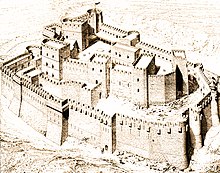Bear windmill


As Bärwindmühle (also bears (wind) mill , shortly bear , rarely also fortified windmill ) is particularly in the Lower Rhine region, where a number of such mills are received, a Tower Mill called, the tower as a defense tower in a town , castle - or other fortress wall built or which is placed on such a defense tower. The tower of such a fortified mill had to be correspondingly thick-walled in order to be able to withstand attacks with heavy projectiles. The name is derived from the resulting massive shape of the tower, which is reminiscent of the squat stature of a bear .
The combination of the defense tower and mill tower enabled better use of the complex tower structure in times of peace and war. In peacetime, the mill tower, largely useless as a fortified tower at that time, nevertheless served a purpose. During the war, the tower was primarily used for defense as an elevated viewing and shooting position. As a rule, it was not possible to use it as a mill during a siege , as the external parts (wings, gallery, harvester) - and also the miller operating it - were exposed to enemy fire without protection. For this reason, during the war, hand or Göpel mills were mostly used to produce flour from stocks of grain and thus improve the food supply of the besieged fortress.
Separately standing tower windmills, which are not integrated into a fortress wall, but are built in the manner of a defensive tower (i.e. with a solid brick tower), are also called "bears" less often. This massive construction is particularly common on the Lower Rhine. In the case of the original Dutch windmills , on the other hand, the tower has a light construction, as a wooden, clad octagon.
Examples
Among other things, the following bear windmills and their towers have been preserved:
- Geldern : mill tower
- Hillesheim (Eifel) : mill tower
- Kaiserswerth (Düsseldorf): town mill
- Kempen : Stadtmühle (mill tower on Hessenwall)
- Cologne : Bottmühle , Gereonsmühle , Pantaleonsmühle, ... (see article on the Cologne city wall )
- Kranenburg : mill tower
- Liedberg (Korschenbroich): mill tower
- Mayen : mill tower
- Neuss : Stadtmühle (today mill tower )
- Orsoy (Rheinberg): Powder tower
- Rees : Stadtmühle (today mill tower )
- Uerdingen (Krefeld): Stadtmühle (today Eulenturm )
- Xanten : Kriemhildsmühle
- Zons : Zonser mill
Picture gallery
Town mill on Hessenwall , Kempen
Mill Tower ( Stadtmühle ), Rees
Kriemhildsmühle , Xanten
Individual evidence
- ↑ Bear IV . In: Rhenish dictionary . tape 9 , supplements, 1971 ( online in the dictionary network of the DFG, University of Trier ).
- ↑ a b Selection: A - D. Lexicon. (No longer available online.) Deutsche Mühlen, archived from the original on October 27, 2007 ; Retrieved January 21, 2013 . Info: The archive link was inserted automatically and has not yet been checked. Please check the original and archive link according to the instructions and then remove this notice.
- ↑ a b Sister Ina Medal 2004: "Wehrmühlenturm Kempen" , Sister Ina Foundation, Kempen 2004, online view
- ↑ Glossary: Bear windmill. Industrial heritage route. Regionalverband Ruhr, accessed on January 21, 2013 .
- ↑ Jürgen Reinke: Bear windmill. Glossary. Castle database (burgendaten.de), accessed on January 21, 2013 .
- ↑ a b c Kriemhildmühle. (No longer available online.) Tourist Information Xanten, formerly in the original ; Retrieved January 21, 2013 . ( Page no longer available , search in web archives ) Info: The link was automatically marked as defective. Please check the link according to the instructions and then remove this notice.
- ↑ a b c Kriemhildsmühle. Industrial heritage route. Regionalverband Ruhr, accessed on January 21, 2013 .
- ↑ Mill dictionary. Mühlenverein Lohmühle in Duisburg-Baerl, accessed on January 21, 2013 .
- ↑ Lazare Carnot, F. von Bressendorf: Instructions for the defense of the fortresses . Cotta, 1820, p. 536 ( limited preview in Google Book search).
- ↑ Gottfried Erich Rosenthal: Encyclopedia of War Studies (= Encyclopedia of all mathematical sciences, their history and literature in alphabetical order . Volume 2 ; tape 5 ). Ettinger, 1794, p. 203, 236 ( limited preview in Google Book search).



